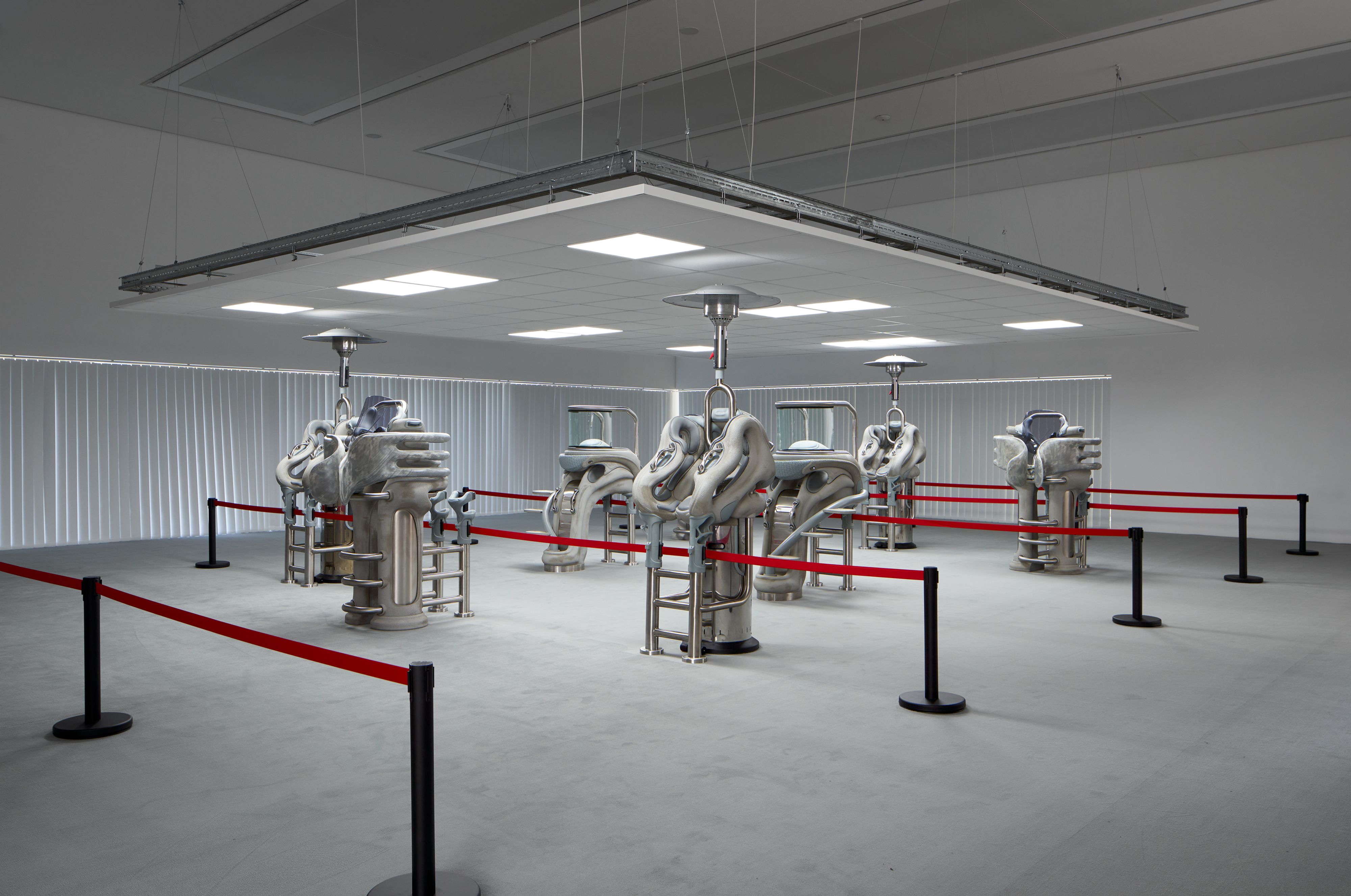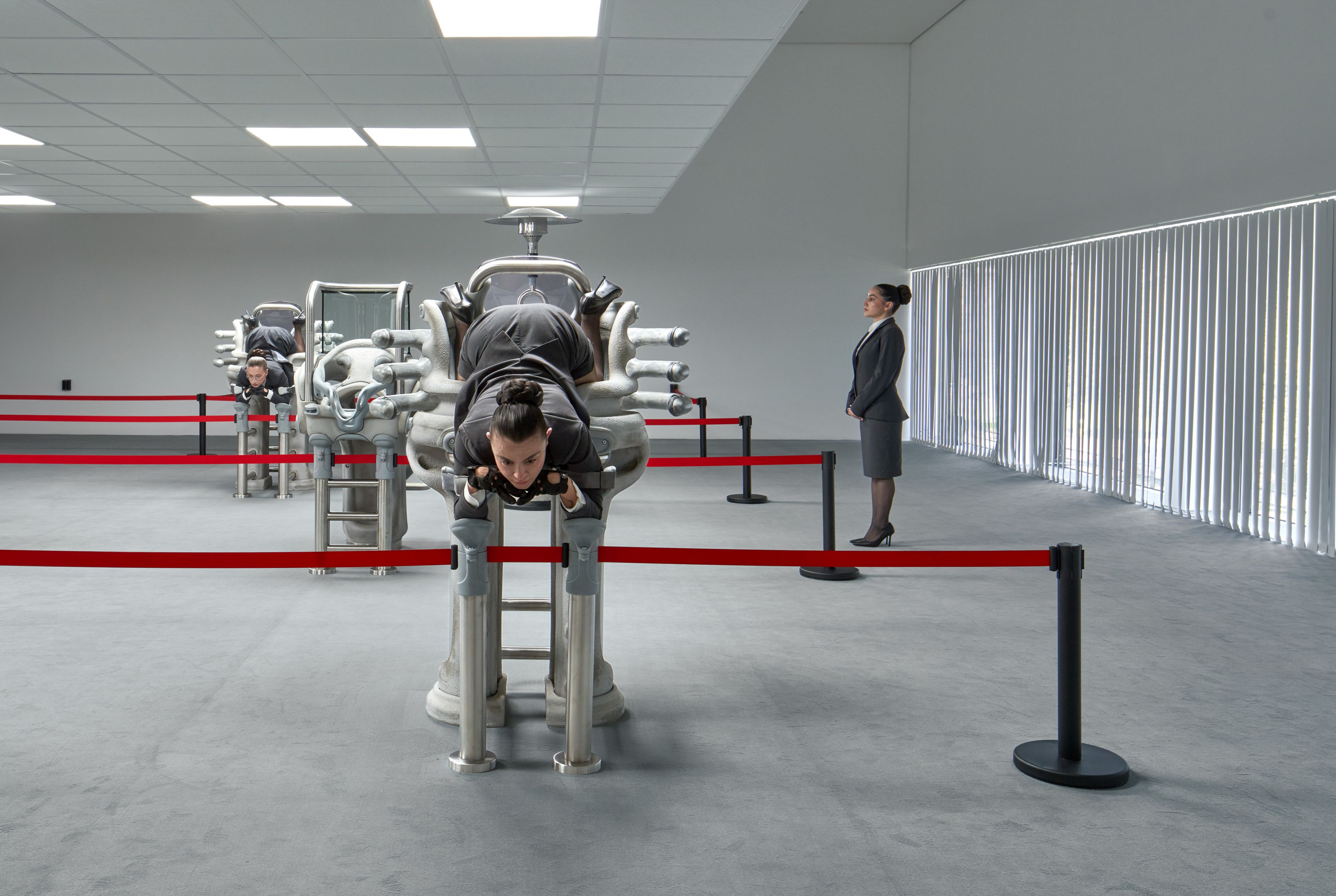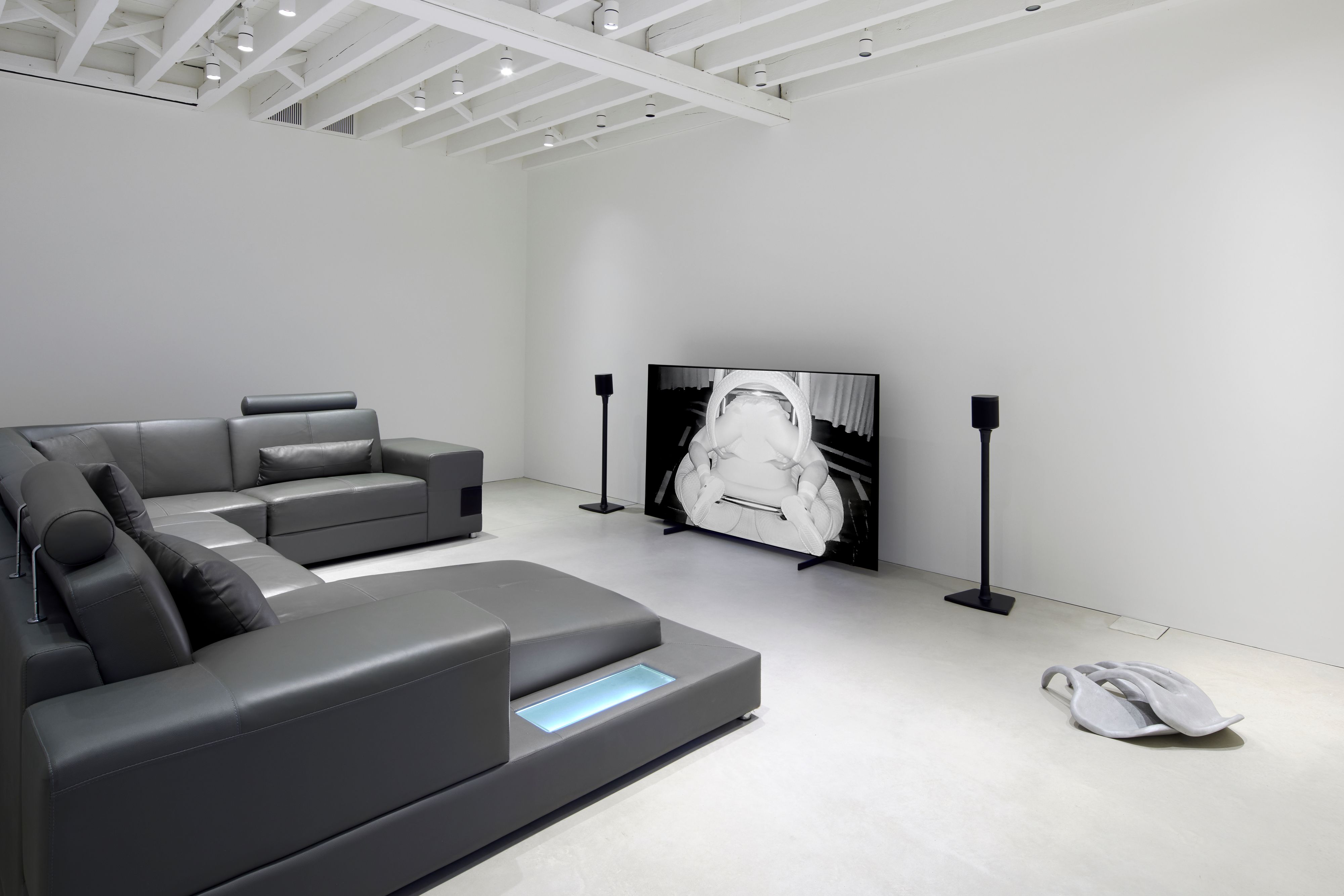
Anna Uddenberg, Home Wreckers at The Perimeter, London, 2023; Photography by Stephen James. Courtesy Anna Uddenberg.

Anna Uddenberg, Premium Economy, installation view, Kunsthalle Mannheim, 2023; Photography by Jens Gerber. © Kunsthalle Mannheim and Jens Gerber.
A figure, all gray synthetic fibers and plastics, lies ass-up with a selfie stick positioned between her legs. Men clad in white diapers and Crocs fold into backward-facing plastic bucket seats with wicker-basket patterning. Power-suited women snap banners from stanchions, whispering to one another, or kneel on platforms that look like some strange cross between an orthopedic accessory, a piece of exercise equipment, and a tortuous amusement park ride. Even if you haven’t directly experienced the uncanny sculptures and performances of Swedish-born, Berlin-based artist Anna Uddenberg, you might have seen her work on TikTok: a performance for her exhibition Continental Breakfast (2023) at New York’s Meredith Rosen Gallery has racked up hundreds of millions of views on the social media platform.
A spatial — or architectural — logic pervades Uddenberg’s work, whether a sculpture is contorted against the wall for a Balenciaga campaign, on the floor of the Boros Collection, or into a bar seat at Berghain. “The figurative work has a tendency to activate what ever environment it’s installed in,” Uddenberg explained during a brief respite between the openings of her exhibition Premium Economy at the Kunsthalle Mannheim and her London show Home Wreckers at The Perimeter. “They relate to their surroundings in that way, but I think Premium Economy takes the space into consideration by modifying the architecture — it’s a different approach.” The tendency toward placing the body in the slippage between object and person was already evident in 2017 with Pelvic Trust at Mexico City’s House of Gaga, an exhibition that featured furniture-like sculptures and a high-heeled figure seemingly mid-twerk against a glass and chrome wall, together recalling a luxury hotel lounge or perhaps a fitting room in a high-end shop.
For Premium Economy, as in Continental Breakfast, the sculptures don’t categorize themselves so neatly as her banquette-ish furniture pieces. Like captchas, they ask us to perform object recognition — but it’s as if we’ve been given the famous “name one thing in this photo” AI meme to work with. For me, the curvaceous Mannheim works, in textured concrete, gray and near-blue plastic, and steel, conjure playground slides, or giant shoes, or raised pulpits. Some are outdoor heaters, while others are used for performances, with silent actors twisting themselves around them into unrestful-looking stillness. In the end, the sculptures don’t do anything that enters the realm of everyday “use,” but their shapes imply figures, or anticipate them — anticipate us. “It’s a way of thinking of a body as a negative space in these sculptures,” Uddenberg elaborates.

Anna Uddenberg, Home Wreckers at The Perimeter, London, 2023; Photography by Stephen James. Courtesy Anna Uddenberg.

Anna Uddenberg, Home Wreckers at The Perimeter, London, 2023; Photography by Stephen James. Courtesy Anna Uddenberg.
She also sculpts the space in which the sculptures are displayed, for example by installing dropped ceilings to lower the Kunsthalle Mannheim’s 23-foot room heights and obstructing its windows with blinds. Red crowd-control belts delineate the remaining claustrophobic space, suspended lower than they’d usually be in an airport or a club line, with each piece’s crutch-like metal scaffold doing double duty as a stanchion.
In her articulation of the subject in space, Uddenberg is a phenomenological artist in the line of sculptors such as Robert Morris (a comparison Caroline Busta singles out in a forthcoming monograph from Kunsthalle Mannheim and Distanz), Mona Hatoum, or Richard Serra. The latter’s leaning steel and massive rusty arcs were partly a reaction to an early relationship with manufacturing and against a contemporary architectural turn from tectonics to historicism. Uddenberg, however, is working in the context of Europe’s post-industrial service sector and an international design reality where, as Hal Foster wrote on Serra in his 2011 book The Art-Architecture Complex, “scenography” defeated “structure,” coming out on top as a “fascination with extreme engineering (Rem Koolhaas in his CCTV in Beijing) and/or digital image-making (Zaha Hadid in nearly all her work).”
Two years ago, Uddenberg invested in a large-scale 3D printer. She designs her sculptures using ZBrush and Rhino, a CAD application popular with architects, sending some printed forms to be sprayed with concrete. But what’s remarkable is that these works are entirely consistent with her earlier hand-crafted objects in styrofoam, polyester, and cut-up car interiors, even if she’s traded “interior” materials like vinyl for concrete, glass, and steel. She had already appropriated and assimilated the aesthetic of product design, but the artisanal approach to a mass-produced aesthetic has been given a digital upgrade.
Uddenberg’s strange objects remind me of running sneakers, gaming computers, or high-end strollers, products that, in the case of sneakers, might have segments divided with different patterns or materials, zig-zags and padding, cutaways and colors that seem to communicate hyper-functionality, but which may in fact be purely aesthetic. While there’s a “seriousness” to putting such pseudo-functional objects into production, Uddenberg says she is “trying to mimic this functional language by inventing other functions, or making fun of the idea that things are important just because they’re functional — or want to look very functional.” If Louis Kahn thought “that ornament is the adoration of the joint,” as Foster wrote, Uddenberg’s work, with its false functionality, suggests that many joints were nothing more than ornament to begin with.

Anna Uddenberg, Premium Economy, installation view, Kunsthalle Mannheim, 2023; Photography by Jens Gerber. © Kunsthalle Mannheim and Jens Gerber.
Serra once argued that the biggest moment in the 20th-century history of sculpture “occurred when the pedestal was removed” and art entered the “behavioral space of the viewer.” But what if the person is the product? Uddenberg’s figurative works construct a spatial relation by virtue of being figures in space — the newer works’ function, if they can be said to have any function, is as plinths for people. Uddenberg’s sculptures highlight how materials and objects act upon us. Her instructions to performers are minimal. “We don’t work from a written script,” she explains. “The performers use the sculpture to inform movements or behaviors, inviting an almost ritualistic way for them to act in the space. I leave a lot of room for improvisation.” Uddenberg exposes how aesthetics have a disciplinary dimension in contemporary consumer culture. This might take a more literal bent, such as in Body Mind (Stretch and Submission) (2011), for which she and two female performers would top off art collectors’ champagne glasses, then ask them to pour some bubbly in their mouths, “mimicking something you’d see in porn.” This performance pointed towards the inherent power dynamics in the art world and the ritualized entertainment of affective service labor. But this interest in power also pervades her sculptural and spatial choices. The stanchions are an obvious example: flimsy fabric that is considered antisocial, or in the case of sites like airports, illegal to ignore or evade.
While performers aren’t given written cues and we can’t tell if, when they place a hand up to the ear of a fellow actor to “whisper,” they’re in fact saying anything, language situates Uddenberg’s practice in the form of titles: Continental Breakfast, Premium Economy, Journey of Self Discovery (2016; a female figure taking an ass pic, her face obscured by a long red wig), Corporate Gray (2021; a sci-fi -like sculpture of a woman with a hair-veiled face in a yogic low lunge). In online skincare and cosmetic “communities,” users are constantly seeking out dupes of high-end products. Like the imitation of functionality, these titles are the ersatz of actual nice things, evoking what writer Venkatesh Rao has termed “premium mediocre.” This is echoed in Uddenberg’s frequent call to the greige-ing of contemporary design, which reaches its apotheosis in the brainless architecture of demi-luxury condos and fully glazed mixed-use buildings. Indeed, Uddenberg collects photos of façade mockups, which architects make to test their to-be-built projects for safety and performance. “These mockups are key,” she explains. “They look like condos, and they have these functional elements, but they’re divorced from their function — they’re just about the material and texture of the building. I try to work towards that with my sculpture.” In these façade prototypes, the consumer status of architecture becomes blatant. They are objects that, to my non-engineer eye, communicate the barest, superficial aesthetic dimension of a building I imagine someone might perform their identity around — or in.
With Uddenberg’s use of Rhino, the same software that makes high rises can make sculptures, recalling the late Anthony Vidler’s observations about design’s digital age. “Between contemporary virtual space and Modernist space there lies an aporia formed by the auto-generative nature of the computer program and its real blindness to the viewer’s presence,” he wrote in 2001. “In this sense, the screen is not a picture, and certainly not a surrogate window, but rather an ambiguous and unfixed location for a subject.” Two decades later we see that the subject self-relocates to the screen, reproducing one’s self as an image in built space, making us not unlike any other shoppable thing. But the reality is we aren’t viewers — we’re bodies in space with one another. As Uddenberg said in an interview with curator Samuel Staples, “One of the key components of phenomenology is the experience of the subject. Your take on this experience might differ depending on which position you see it from, who you are. Heidegger speaks about technology as a mode of being. He’s not against technology, but he argues that it is not something we can just blindly use to do our work. We respond to the technology we use — it changes our own behavior as well.”

Anna Uddenberg, Home Wreckers at The Perimeter, London, 2023; Photography by Stephen James. Courtesy Anna Uddenberg.
The earliest of Uddenberg’s works listed in the Mannheim catalogue is Girlfriend Experience (2009), a film in which she “was thinking about how the self could be performed and staged” as well as the advent of the “artist as entrepreneur.” She wears a long, slinky black dress with a fur collar, sitting with poise in a Minsk mall atrium, where the first 30 seconds or so of the two-minute work were filmed. Security guards soon escorted Uddenberg out; the rest happened in front of a green screen. Now, 14 years later, Uddenberg has made another film, shown as part of Home Wreckers. Created in collaboration with Thyago Sainte, Untitled records performers engaging with Uddenberg’s own sculptures. If in Minsk the products were the familiar consumer crap, in Untitled they are the absurd performance-sculptures, traced by an elegant blonde woman with a teasing smile, a Berlin-art-world Vanna White. The figure becomes the ground.